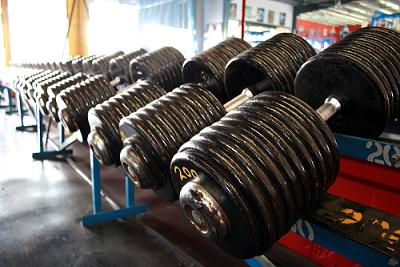Anthony Donskov
Anthony Donskov is the founder of DSC where he serves as the Director of Sport Performance. Donskov holds a Masters Degree in Exercise Science & is the author of Physical Preparation for Ice Hockey.
Sequencing
- Font size: Larger Smaller
- Hits: 4474
- Subscribe to this entry
- Bookmark
Sequence: A strict order of succession. Although there are a plethora of programming variables (training age, motor priorities, sport, exercise selection, exercise order, tempo, rest, intensity, density, duration, frequency, regeneration) it seems like the art of sequencing has taken a back burner. There are two forms of sequencing that we use at Donskov Strength and Conditioning when writing our programs, small picture and big picture sequencing. We aim to keep things simple.

Small Picture Sequence:
Call it a microcycle, phase, or several weeks of a training block, but when we look at this timeline, our laws of small picture sequencing state:
1.) All exercises done with high contraction velocity will be done first.
2.) Ensure appropriate regeneration between workouts.
Single Training Session Sequence:
- Plyometrics
- Speed Work
- Olympic Lifts
- Strength Training
- Conditioning
OR
- Max Effort Work/OR Dynamic Effort work
- Auxiliary/Assistance Lifts
Multiple Training Session Sequence:
“The connection between workouts is ensured by the continuity of the immediate, delayed and cumulative effects.” (Kurz)
- 2/week program: Two full body lifts (48 hours apart).
- 4/week programs: Lower/Upper Body Split (48-72 hours apart). We will sequence lower body with upper body pull on day 1 and 3, and upper body push, press on day 2 and 4.
Big Picture Sequence:
When looking at the big picture (macrocyle, full length 12 week program) our laws of sequencing state:
1.) Ensure that motor abilities act as “favorable prerequisites” for the next training session/block.
2.) Fluctuate the training loads/exercises in waves (we use 3 week waves).
Here is an example of how we sequence our beginner athlete’s at DSC:
Beginner Sequence (Concurrent/Undulating Model. Each phase is 3 weeks):
- Phase 1: Increase TUT (time under tension). Call it GPP, repetitive effort method or work capacity. We just call it Phase 1. We typically use 3x8 (total volume of 24 attempts/lift).
- Phase 2: Strength gains. We typically use 3-4x5 at higher intensities (total volume of 15-20 attempts/lift).
- Phase 3: Another increase of intensity. We use 3-5x3 (total volume of 9-15 attempts/lift).
- Phase 4: Strength Endurance. In our final phase we are preparing the athlete for training camp/tryouts. We cut back on volume and intensity in order for a cumulative delayed training effect proceeding pre-season competition. Our workouts look more like circuits focusing on speed-strength/endurance.
Here is another example of an advanced training sequence from Westside Barbell:
Westside Sequence: Conjugate Method: Training qualities simultaneously (Rotating special exercises that are close in nature). Developed in Russia by the Dynamo Club in 1972. Each wave is 3 weeks. Both load and exercise will change during each wave.
- Max Effort Method followed by Dynamic Effort Method (72 hours later). Their training schedule looks like this:
- Monday (Max Effort Squat/DL), Wednesday (Max Effort Bench), Friday (Dynamic Squat/DL), Sunday (Dynamic Bench).
- Westside’s Keys to success: 1.) Volume with correct intensity, 2.) Max Effort (72 hours later), Dynamic Effort, 3.) Raise Work Capacity.
Block Models are similar but focus on training motor abilities separately (consecutively vs. concurrently). Depending on the needs of the athlete, the block model may choose sequencing based on motor ability or lack thereof. The biggest difference is the specialization of the blocks and the load/modality that accompanies it.
Sequencing Gone Wrong: (I won’t mention where I got this. But I can guarantee your first guess is correct)
Day 1: (For time)
225 pound Hang clean: 30 reps
One-legged squats: 50 reps
Alternating Row 2000 meters
Day 2: (48 hours later)
1000 meter Row
Rest 4 minutes
Dumbbell "Tabata" Thrusters
Day 3: (less than 24 hours later: For time)
25 GHD sit-ups
1 Muscle-up
20 GHD sit-ups
2 Muscle-ups
15 GHD sit-ups
3 Muscle-ups
10 GHD sit-ups
4 Muscle-ups
5 GHD sit-ups
5 Muscle-ups
Day 4: (24 hours later) Five rounds for time:
115-pound Push press: 12 reps
40 meter Shuttle sprint (4 x 10 meters)
115-pound Squat snatch: 8 reps
These are just a few examples of how we sequence at our facility and in the strength and conditioning world. It can get complex, but we choose to keep it as simple as possible. What does the athlete need? What does he/she lack? Can we provide favorable circumstances to realize these abilities? Our goal is summed up well by Thomas Kurz: “To develop and maintain any ability or skill, the coach should use the least training load necessary to deliver a desired result.” Sequencing is a BIG part of this result.
References:
(1) Kurz, T., Science of Sport Training, Stadion Publishing, 2001.
(2) Verkhoshansky, Y., Programming and Organization of Training, Sportivny Press, 1988.
(3) Verkhoshansky, Y., Fundamentals of Special Strength Training in Sport, Sportivny Press, 1986.
(4) Simmons, Louie, The Westside Barbell Book of Methods, 2007.
Anthony Donskov, MS, CSCS, PES, is a former collegiate and professional hockey player, founder of Donskov Strength and Conditioning Inc., (www.donskovsc.com) and Head Instructor/Director of Off-Ice Strength and Conditioning for Donskov Hockey Development (www.donskovhockey.com). He can be reached at info@donskovsc.com .
Facebook: http://www.facebook.com/pages/Donskov-Strength-and-Conditioning-Inc/111694352189187
Twitter: http://twitter.com/Donskovsc
